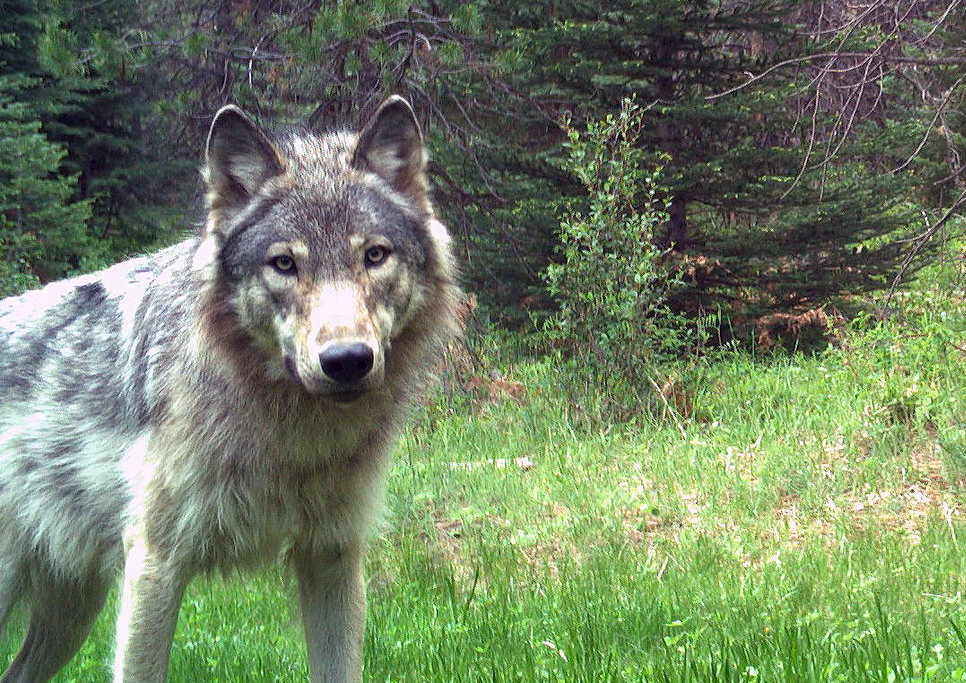
FILE: A gray wolf from Oregon's Desolation Pack is captured on a remote camera in Grant County on June 7, 2021. Conservation groups have filed a lawsuit challenging the federal government's decision to decline new Endangered Species Act protections for western gray wolves.
Photo courtesy of the U.S. Forest Service
Conservation groups are taking the federal government to court over environmental protections for gray wolves across the West.
Earlier this year, the U.S. Fish and Wildlife Service concluded western gray wolves did not warrant listing under the Endangered Species Act.
If those protections had been granted, they would have applied to wolves in northeastern Oregon and southeastern Washington, where those states have the highest concentrations of wolves. Wolves in remaining portions of those states are federally listed as endangered.
In their lawsuit filed in a Montana district court early Monday morning, the 10 environmental groups called the agency’s decision “arbitrary, capricious, an abuse of discretion, and not in accordance with the ESA.” The legal complaint asks the court to vacate the Fish and Wildlife Service’s decision to not federally protect gray wolves in the West.
“The service’s decision fails to adequately consider the threats to the species from human-caused mortality and inadequate state regulatory mechanisms,” Western Environmental Law Center staff attorney Kelly Nokes said, adding that environmental groups are particularly concerned about Idaho and Montana laws allowing people to hunt or trap wolves.
The U.S. Fish and Wildlife Service has long considered wolves in northeastern Oregon and southeastern Washington to be part of the Northern Rocky Mountains distinct population segment, along with wolves in Idaho, Montana, Wyoming and a small part of Utah. While wolves in other parts of the West are federally protected, Rocky Mountain wolves are not listed as threatened or endangered.
Environmental groups in 2021 petitioned the agency to either grant federal protections to Rocky Mountain wolves, or lump them into a broader western wolf population and list that under the Endangered Species Act. In February, the agency agreed that wolves across the West — including those in the Northern Rockies — could be considered their own distinct population segment, but said that population as a whole doesn’t qualify for species protections.
Related: For some Oregonians, losing 10 wolves to Colorado is complicated
That decision maintained the status quo. It meant states within the Rocky Mountain region could continue managing wolves however local policymakers liked — including in northeastern Oregon and southeastern Washington, where state officials allow ranchers to kill wolves that have recently killed livestock.
Many Oregon conservationists say they are concerned about the state’s wolf populations, which have stagnated in recent years as human-caused deaths have increased. They say federal protections in just one corner of the state could make a big difference, since that’s where most Oregon wolves roam.
“That’s where wolves will be migrating from, and they’re nowhere near recovery on the western side,” said Sristi Kamal, deputy director of the Western Environmental Law Center’s Portland office. “So we are heavily reliant on our eastern wolf population to be able to continue on the recovery path for Oregon.”
Late last year, Oregon allowed Colorado to trap and relocate 10 wolves as part of that state’s reintroduction efforts. The Oregon Department of Fish and Wildlife is expected this month to release its annual wolf report for 2023, which should reflect how those relocations and other wolf losses affected Oregon’s overall population.




